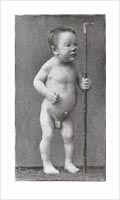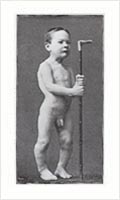



Edinburgh : Oliver and Boyd, 1891-93.
Description : [4 fl], 50 pp, 3 pl., [4 fl] ; ill., 3 pl.s (1 fold.), 21.5 cm.
Photographs: 6 photoglypties on 3 leaves.
Photographer : Stevenson.
Subject : endocrine disorders, thyroid treatment.
Note :
Titles of Essays :
1. A case of sporadic cretinism treated by thyroid feeding. (reprinted from EMJ, May 1893).
2. Note on a case of myxoedema which ended fatally shortly after the
commencement of thyroid treatment. (read before the Society, February 16,
1893).
3. On infantile respiratory spasm (congenital laryngeal stridor). (read
before the Society, June 1, 1892).
4. Scorbutic haematuria in an infant. (reprinted from The Lancet, June 11, 1892).
5. On a case of myxoedematoid swelling of one-half of the body in a
sporadic cretin. (reprinted from EMJ, September 1891).
6. Further notes of a case of sporadic cretinism treated by thyroid feeding.
(reprinted from EMJ, February 1894).




The first essay, A case of sporadic cretinism treated by thyroid feeding, is illustrated with two sepia photographs. They are identical except in color to Plates I and II on the fold-out leaf of photographs which illustrates the last essay, Further notes of a case of sporadic cretinism treated by thyroid feeding.
The images are a remarkable document in the history of endocrinology, a branch of medicine which is generally acknowledged to originate in the clinical work of the British physician, George Redmayne Murray. In 1891, Murray presented a case of myxoedema to his associates at the Northumberland and Durham Medical Society in England. His patient "Mrs H." was a forty-two year old mother of nine children whose symptoms included hypersensitivity to cold, slowness of speech and gait, debilitating weakness, and mucin swelling in the face and hands. These symptoms described the condition of myxoedema which was identified by W. W. Gull and W. M. Ord in the 1870's and corresponded precisely to a condition (cachexia strumipriva) suffered by patients who underwent surgical removal of the thyroid also described by Reverdin of Geneva in 1882. Working against the criticism of his colleagues, Murray thought to treat his patient with injections of a glycerin extract which he compounded from the thyroid glands of sheep, freshly slaughtered. With twice weekly, 24 drop injections of Murray's extract, the brave Mrs. H. found her condition improved dramatically and within a week her strength was returned to her.
Murray was treating the adult form of myxoedema, however in 1888 the Clinical Society of London Committee on Myxoedema identified deficient thyroid function as the cause of both adult myxoedema and infantile sporadic cretinism, and probably the cause of infantile endemic cretinism as well. Murray's treatment was soon adopted by clinicians to treat cases of sporadic cretinism with even more dramatic results, especially in bone growth which can add up to six inches to a child's stature in less than a year of thyroid treatments. Bone growth can be so rapid that deformity becomes a problem if the child is not kept in bed or put in orthopedic restraints to direct the spurting limbs. John Thomson reported a remarkable 4 3/8 inches of growth in his patient "A. C." after a year of thyroid treatments.
A comparison of the Plates shows, even more strikingly than the notes do,
the radical change which the patient has undergone.
In Plate I., in spite of his infantile proportions, there is a look of
premature maturity (if one may say so) about his figure, and even in
his attitude there is a suggestion of decrepitude.
In Plate II., his whole aspect is changed. The dull apathetic glance is
gone, he "eyes the world now like a child," and even in the way he stands
and grasps the stick he is holding there is something of vigour and hopeful
vitality, so that one can hardly resist the conviction that (like a child)
he has a long process of bodily and mental growth and development in
front of him.
Ordinary nineteenth century therapeutics yield us no analogy to guide us
in our conjecture, or how long the improvement so vigorously begun is
likely to continue, or how far it is likely to go. Only time can show.
But when we note the change in his appearance and character wrought in
the short space of three months, we are certainly tempted to rather a
sanguine prognosis.
Unfortunately, the total cure hoped for by Thomson soon tempered into something a little less miraculous as A.C.'s neuro-psychological problems stubbornly resisted improvement. A.C.'s sister who was a schoolteacher tried to teach her feeble brother how to count, but with the "least success". Thomson found it significant that A.C. took of his clothes to prepare for bed one night, something which his patient never did before. He also observed improved socialization in A.C., a lessening in his morbid shyness and a general improvement in his capacity to enjoy life.
It is a defect of these two essays that Thomson makes little mention of the work of other clinicians treating for hypothyroidism, Murray in particular.
